
views
Identifying False Widow Spiders
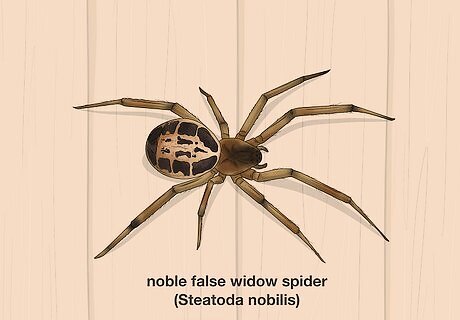
Noble false widow spider (Steatoda nobilis) The noble false widow is the largest and the most common of its species. Noble false widow spiders typically build messy, tangled webs in window frames, dark corners, and gardens. They’re typically shy, so they’ll leave you alone unless you put your hand in their web or handle them roughly. Size: 8 ⁄2–14 mm (0.33–0.55 in) for females, 7–10 mm (0.28–0.39 in) for males Color: Dark brown bodies and legs, cream coloration on the abdomen Distinguishing features: Skull or pentagon pattern on its back Geographic Location: Europe, Pacific Coast of North and South America

Cupboard spider (Steatoda grossa) Also known as false black widows, these spiders have bodies the same size and shape as a black widow, but they never have a red hourglass marking on their abdomen. Cupboard spiders thrive by building tangled cobwebs in bathrooms, laundry rooms, cupboards, and basements. Size: 6–11 mm (0.24–0.43 in) for females, 4–7 mm (0.16–0.28 in) for males Color: Dark brown or black bodies and legs Distinguishing features: Light T-shaped marking with a line running down their back Geographic Location: North America, Australia, and Europe
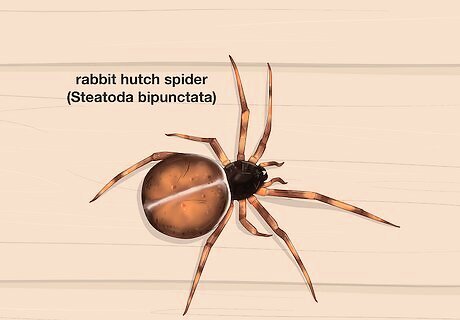
Rabbit hutch spider (Steatoda bipunctata) Rabbit hutch spiders typically don’t bite humans and they’re commonly found in animal pens, sheds, and garages. Size: 7 millimetres (0.28 in) for females, 5 millimetres (0.20 in) for males Color: Dark brown bodies and light brown legs with darker bands Distinguishing features: Pale cream T-shape and 2 spots on their abdomen Geographic Location: North America and Europe

Mediterranean false widow spider (Steatoda paykulliana) While Mediterranean false widow spiders look the most similar to black widows, they’re also the least common. These spiders are invasive from fruit and vegetable shipments, but they make their homes in areas without a lot of vegetation, like vineyards. Size: 8–13 mm (0.31–0.51 in) for females, 4 ⁄2–6 mm (0.18–0.24 in) for males Color: Dark brown or pure black bodies Distinguishing features: Red, orange, yellow, or red lined markings on their back Geographic Location: Mediterranean Europe and Western Asia
Are false widow spiders dangerous?

No, false widows rarely bite humans and have less potent venom. Even though false widows are venomous, they aren’t as dangerous as a black widow. False widows only bite if you stick your hand in their nest, handle them too roughly, or sit on them by mistake, and the pain is similar to a bee sting. Typically, you’ll just feel pain around the bite that will go away within a day without any treatment. If you do get bitten by a false widow, treat the bite by washing it soapy water. Hold a cool compress against the bite to relieve the pain. If you still feel pain and itchiness, take an over-the-counter pain reliever and antihistamine. If you’re bitten but aren’t sure what kind of spider did it, try to catch it. Contact your doctor and let them know your symptoms and what the spider looked like to learn the next steps.
Spiders Mistaken for False Widows
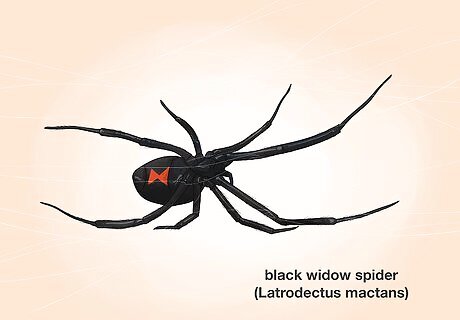
Black widow spider (Latrodectus mactans) Black widow spiders have solid black bodies and females grow up to 38 mm (1.5 in) when their legs are fully extended. Black widows tend to hide in dark undisturbed corners with tangled, sticky webs. You’ll easily identify a black widow by the red hourglass marking on the bottom of its abdomen. Male black widows are about half the size of females and have yellow or red spots along their sides. Black widows are venomous and their bites can cause pain, muscle tightness, swelling, nausea, and vomiting. If you suspect you were bitten by a black widow spider, treat the bite right away by washing it with soapy water and seeking medical help immediately.

Brown widow spider (Latrodectus geometricus) Brown widow spiders grow to about 10 mm (0.39 in) and have a mottled tan, brown, or gray coloration. They have diagonal stripes on the sides of their abdomen and 2 large square dots separated by a line on their pattern. They may still have an hourglass marking where the bottom half looks larger. Brown widow males are about half the size of females and are not harmful. Brown widow spiders are not toxic to humans like black widows. Their bite may cause slight irritation, but they’ll generally leave you alone.
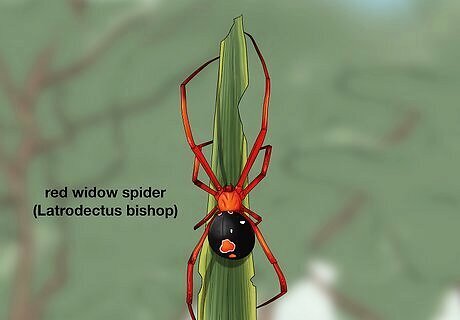
Red widow spider (Latrodectus bishop) Red widow spiders have the same body shape and size as a black widow, their bodies and legs have a bright red color while their abdomen is a dark brown. They may have a red hourglass marking on the bottom of their abdomen, but it may also be spotted with orange or yellow.
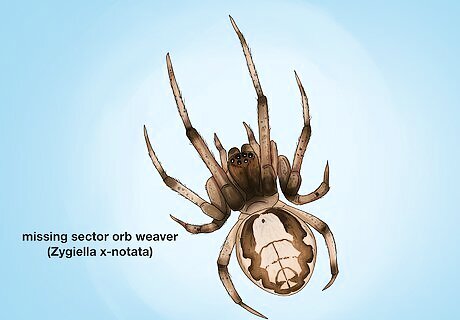
Missing sector orb weaver (Zygiella x-notata) The missing sector orb weaver is a larger type of spider that spins large, round webs. These spiders grow up to about 7 millimetres (0.28 in) and have medium to dark brown bodies. They have a brown leaf-shaped mark on their back surrounded by a silvery sheen. These spiders have a distinct web that looks like it has a hole in one of the sections. Missing sector orb weavers typically live near window frames or sills or in garden shrubs.

Lace webbed spider (Amaurobius sp.) Lace webbed spiders are a common subspecies that look similar to false widows but are harmless to humans. Lace webbed spiders typically grow between 5–15 mm (0.20–0.59 in) in length, and the males are half the size as the females. They typically have medium to dark brown bodies and legs, and they may have lighter-colored stripes on their abdomen. Lace webbed spiders typically make their homes outside, but they may also live near window frames, crevices in masonry, or in cellars.

Domestic house spider (Tegenaria domestica) Also known as the barn funnel weaver, this spider typically grows to around 7 ⁄2–11 ⁄2 mm (0.30–0.45 in). They typically have a red-brown body with pale gray legs. Their abdomen may have a pink or pale fleshy pattern with black or gray patches. These spiders are not known to bite, so they’re completely safe to keep around. Domestic house spiders are usually found around entryways, sheds, and dark crevices hidden away from danger.
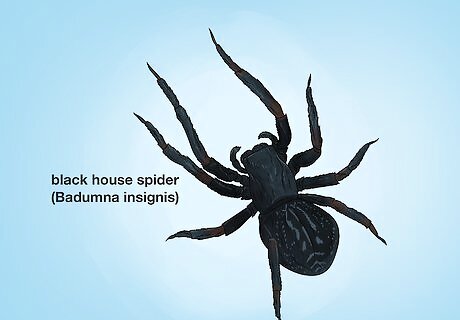
Black house spider (Badumna insignis) Black house spiders are large black spiders that can get up to 18 millimetres (0.71 in), but they’re not aggressive toward humans. They have dark brown or black bodies with solid black legs. They do not have a pattern on their back, so they’re easy to distinguish from other false widow look-alikes. Black house spiders build messy webs around window sills or on trees that they rarely leave.
Controlling False Widows

Catch and release false widows outside. Because false widows aren’t harmful and will only bite when they’re provoked, you don’t need to kill them. Catch the spider by covering it with a cup or glass jar, and then sliding a piece of paper underneath to trap the spider inside. Take the spider outside away from home and let the spider go. Spiders in your yard can help control other common flies and pests, so they’re nice to keep around. If catching the spider isn’t an option and you want to kill it, use a hose attachment on your vacuum to suck it up. Alternatively, squash the spider with a shoe or swatter.

Clean up clutter around your home. False widows and their look-alikes tend to make their nests in dark, undisturbed corners where they can easily hide. Start by getting rid of the clutter in your home and tidying up any messes. Use airtight containers or tape boxes closed so spiders don’t find their way inside. Once you eliminate the hiding spots, spiders will find a new place to call home. Wear a thick pair of gloves while you’re cleaning up to protect yourself from any bites from hiding spiders.
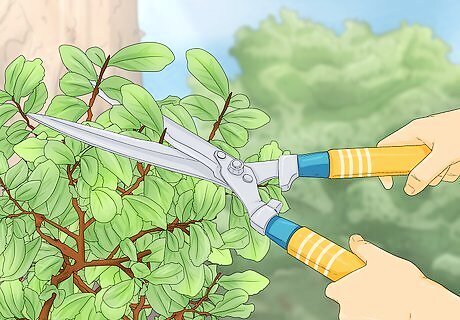
Trim back vegetation around your home. When shrubs and plants brush up against the exterior walls, spiders have an easy way to get into your home. Trim all your plant’s foliage so it’s about 6 inches (15 cm) away from the side of your home. Then, check for any branches overhanging your home and prune your tree to remove them. Trimming your plants also removes hiding places for spiders, so they’re less likely to build webs next to your home.
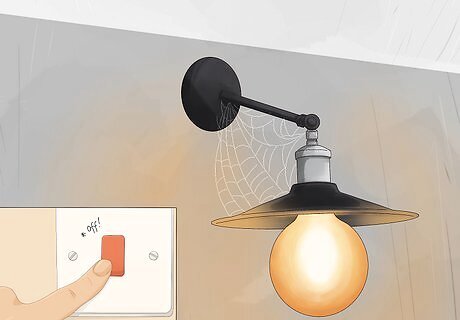
Keep outdoor lights turned off. Outdoor lights attract flying insects that false widows and other spiders like to eat. Shut off any exterior lights around windows and entryways when you don’t need them so spiders are less likely to find their way in. If you want to leave exterior lights on, try using a yellow bulb that attracts fewer insects.
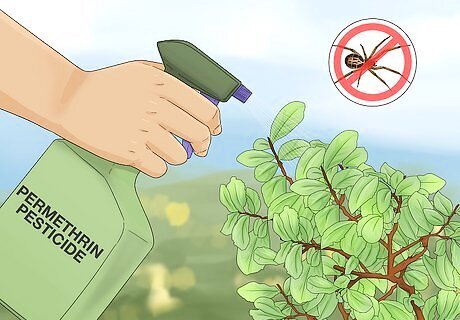
Apply pesticides as a last resort to eliminate the spiders’ prey. Use a permethrin pesticide spray because it helps control spiders as well as other pests they feed on. Spray the pesticides indoors in cracks, voids, crevices, and between baseboards. To keep spiders from coming into your home, use a barrier spray around your home’s exterior to kill other pests and deter spiders from coming in. Pesticides usually aren’t required to control false widows and they may harm beneficial insects outdoors, so only use them if you have a serious spider problem. Follow all the pesticide’s instructions carefully before using them. These pesticides are not safe around pets or children until they’re dry.














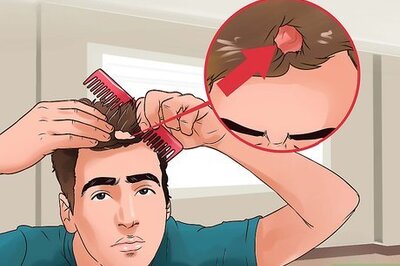





Comments
0 comment